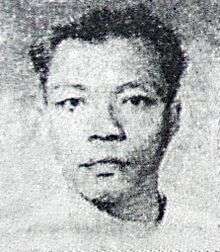Max Tera
Max Tera (25 October 1920 – 1 October 1992) was an Indonesian cinematographer and editor. He was employed by PERFINI in the 1950s and was a frequent collaborator with director Usmar Ismail.[1]

Biography
Tera was born on 25 October 1920 in Madiun, East Java, Dutch East Indies. He continued his education until junior high school, later becoming a photographer.[2]
Around 1948, during the Indonesian National Revolution, Tera joined the Dutch-owned production company South Pacific Film Corporation, where he studied cinematography under the Dutch cameraman AA Denninghoff-Stelling. With South Pacific, Tera served as assistant cinematographer for several productions, including Djaoeh Dimata (1948), Gadis Desa, Harta Karun, and Tjitra (all 1949). It was while working there Tera met Usmar Ismail, who was the director of Harta Karun and Tjitra.[2]
After the end of the revolution in December 1949, Ismail began work on Darah dan Doa (The Long March; 1950). Tera was asked to join the production.[2] Shooting began on 30 March 1950, a date which is now celebrated as National Film Day in Indonesia.[3] After the film was released, it was ultimately unsuccessful.[4] Despite this, Tera remained with Ismail's company Perfini, later training several of its cameramen, including Kosnen, R. Husein, and Kasdullah.[2]
In the 1960s Tera began working for films by other companies, with Perfini's permission. In his later years Tera worked freelance, both for money and because he felt he was destined to be a cinematographer.[2] He made his last film, Nuansa Birunya Rinjani, in 1989.[5] In 1990 Tera was awarded an Usmar Ismail Prize for his contributions to Indonesia's cinema. He died in Jakarta on 1 October 1992.[2]
Filmography
During his forty-one-year career Tera was involved in some 56 productions, mostly as cinematographer.[5] The following is a list of his works; positions other than head cinematographer are noted.
|
|
References
- Horison. Jajasan Indonesia. 1987. Retrieved 12 January 2013.
- "Max Tera". filmindonesia.or.id (in Indonesian). Jakarta: Konfidan Foundation. Archived from the original on 23 August 2012. Retrieved 13 January 2013.
- "Long March, The (Darah dan Doa) | Kredit" [Long March, The (Darah dan Doa) | Credits]. filmindonesia.or.id (in Indonesian). Jakarta: Konfidan Foundation. Archived from the original on 11 January 2013. Retrieved 11 January 2013.
- Anwar, Rosihan (2004). Sejarah Kecil Petite Histoire Indonesia. Jakarta: Kompas. p. 89. ISBN 978-979-709-428-7.
- "Max Tera | Filmografi" [Max Tera | Filmography]. filmindonesia.or.id (in Indonesian). Jakarta: Konfidan Foundation. Archived from the original on 13 January 2013. Retrieved 13 January 2013.